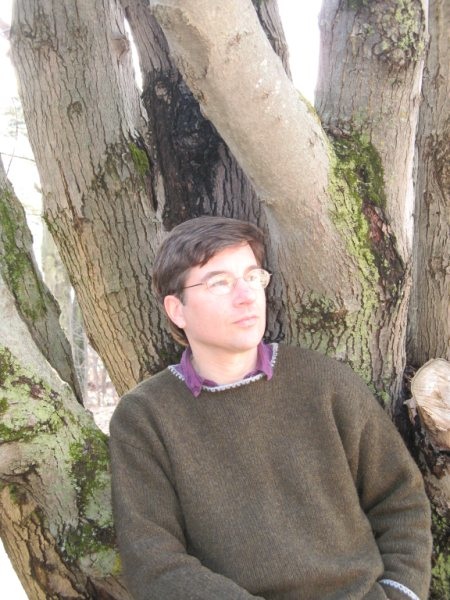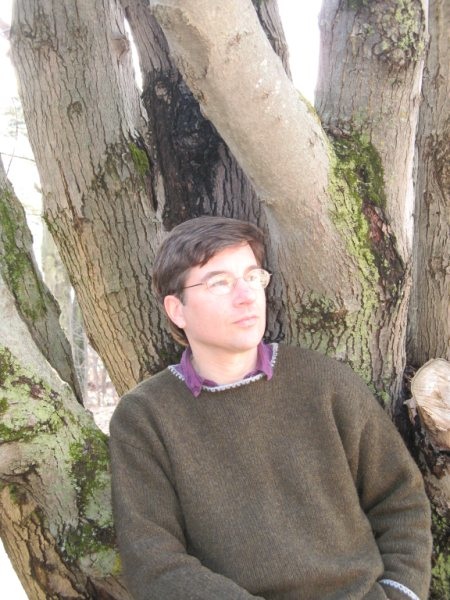 Bee there, do that: organic beekeeper Ross Conrad. Beekeeping is rising in popularity–from urban rooftops to backyard hives, the world is abuzz with interest in homemade honey. And who better to comment on the nature of bees than the former president of the Vermont Beekeepers Association, Ross Conrad. He’s led bee-related presentations and taught organic beekeeping workshops and classes throughout North America for many years, and Conrad’s small beekeeping business supplies friends, neighbors, and local stores with honey and candles among other bee related products, not to mention provides bees for Vermont apple pollination in spring. I talked to Conrad about organic beekeeping, the state of pollination, and tips for aspiring bee farmers.
Bee there, do that: organic beekeeper Ross Conrad. Beekeeping is rising in popularity–from urban rooftops to backyard hives, the world is abuzz with interest in homemade honey. And who better to comment on the nature of bees than the former president of the Vermont Beekeepers Association, Ross Conrad. He’s led bee-related presentations and taught organic beekeeping workshops and classes throughout North America for many years, and Conrad’s small beekeeping business supplies friends, neighbors, and local stores with honey and candles among other bee related products, not to mention provides bees for Vermont apple pollination in spring. I talked to Conrad about organic beekeeping, the state of pollination, and tips for aspiring bee farmers.
Makenna Goodman: Your book, Natural Beekeeping: Organic Approaches to Modern Apiculture, offers up a program of natural beehive management, and an alternative to conventional chemical-based approaches. So—why organic beekeeping?
Ross Conrad: History has shown us that the industrialized “economy of scale” approach does not work when applied to agriculture because we are dealing with living biological systems, not an inert assembly line food production system where the economy of scale approach can be applied across the board. One of the biggest issues is the large number of chemical contaminants that are being found in beeswax and pollen, often at very high concentrations. Toxic chemical contamination has been implicated in Colony Collapse and the reality is that there is no effective regulation of chemicals in Western society. Let me tell you why:
When the EPA was created in 1970 and sanctioned with the task of regulating chemicals, all the chemicals that were already used in commerce up to that time were grandfathered in. Additionally, since the EPA is given very limited personnel and financial resources, the agency ends up relying on the chemical manufacturers for the majority of the scientific data that is used to evaluate the safety of the regulated toxins…a serious conflict of interest. When chemicals are evaluated for toxicity, they are studied in isolation. Little thought is given to the chemical’s break down products which can prove to be more toxic and longer lasting than the original chemical itself, such as in the case of Imidacloprid Olefin, which is produced as the neonicotinoid, Imidacloprid degrades. Once in use and released into the environment, chemicals, and their breakdown products, will combine with other chemicals already in the environment to form new compounds. The synergistic effects of some of these combinations have proven themselves to be hundreds of times more toxic than either compound on its own.
Recent research into endocrine-disrupting chemicals (the kind often used as pesticides), reveals that the timing of exposure combines with the amount of exposure to produce a chemical’s effect. Thus, a certain dose might be very toxic to an organism in its developmental stage, while not having any obvious detrimental affects on the organism once it has matures, or vice-verse. To make matters worse, in some cases low doses of a chemical can be more damaging than higher doses. These new understandings of chemical toxicity have proven wrong Paracelsus’s 450-year-old maxim, “The dose makes the poison.” Today we know that often the timing can make the poison and that sometimes less is actually worse.
Add to this the many studies that now show that a cocktail of “insignificant” doses of several chemicals each acting on their own can combine to have significant results. In other words, exposure to very low concentrations of several chemicals at the same time can cause biological effects that none of the chemicals would have on their own. Thus when an living organism is exposed to a mixture of chemicals, every component contributes to the overall effect, no matter how minute their concentration. The only sane answer to our ignorance in the use of these toxic compounds is to stop using these chemicals, not only in our hives, but in our everyday lives. Thus, organic beekeeping came into being in just the last 20 years as a response to the fact that chemical use in bee hives has became the common way to try to control Varroa mites. Organic beekeeping is not only possible, but necessary.
What are the biggest obstacles faced by organic beekeepers today?
The biggest challenge beekeepers face today is the same challenge facing all of Western industrial civilization…
In his 1980 book, Overshoot, William Catton, Jr. states, “Infinitesimal actions, if they are numerous and cumulative, can become enormously consequential.” This statement refers to the problem of cumulative impacts where actions that are harmless or tolerable at the individual level can degrade the planets life support systems if thousands or millions of people do them. One person fertilizing their lawn near Chesapeake Bay for example makes no significant impact, but when thousands do it the bay becomes degraded and Blue Crab populations decline precipitously.
When it comes to chemicals the current regulatory approach to controlling pollution does not deal with global pollution. The main focus has instead been on the maximally exposed individual. In the United States, we conduct risk assessments (used when conducting “cost-benefit” analyses) to evaluate the risk to a hypothetical “maximally exposed” individual. If the threat to that individual (or honey bee) is found to fall within acceptable limits, then regulation does not occur and these so-called acceptable amounts of contamination are allowed to be released forever after. Then another risk assessment and cost benefit analysis gives the go-ahead to another acceptable release or use of a different toxic substance or harmful activity. Then another and another. What we have not started to look at until recently is the total impact of all these acceptable risks. Our society has assumed that it could tolerate unlimited small amounts of harm as a byproduct of economic growth. It is only when a particular activity is demonstrated to fail to provide a net benefit to society that most of our property and environmental laws are permitted to interfere with economic activity.
Biochemist and lawyer, Joseph H. Guth, legal director of the Science and Environmental Health Network, has analyzed this situation and offered solutions in several scholarly papers one of which was published in the Barry Law Review, titled “Cumulative Impacts: Death-Knell for Cost-Benefit Analysis In Environmental Decisions.” In this paper Guth points out that our laws only forbid damage when the perceived benefits are not considered to outweigh the cost or destruction to the environment or human health. The law also puts the burden of proof that an activity is creating more harm than good on the injured party, or the government. If the victim (or the government) can not meet the burden of proof, then the damaging action is allowed to continue by default. This burden of proof transforms doubt, and missing scientific information into a barrier to legal protection for the environment (and honey bees). The default presumption is that the benefits of economic activity always outweigh the costs unless a specific cost-benefit analysis (often based upon incomplete or faulty research conducted by those that stand to profit) can show otherwise.
According to Joe Guth, “These laws do not permit regulators broadly to take account of what is happening to the world around them. They embed regulators in a decision-making structure that may seem scientific but in fact is profoundly unscientific because it prevents them from responding to the ever more detailed findings by the world scientific community that we are overshooting the Earth’s ecological capacities. Rooted in the assumption that ecological overshoot does not occur, our current statutes are incapable of containing the cumulative scale of ecological damage… It is an approach that has become outdated because it is based on assumptions that are no longer valid.”
Guth sums up by stating, “To maintain a functioning biosphere in which humans can prosper, the law must turn its attention to the problem of cumulative impacts. The law will have to abandon its use of cost-benefit analysis to justify individual environmental impacts and instead adopt the goal of maintaining the functioning ecological systems that we are so dependent upon.”
In Section II of his “Cumulative Impacts” paper, Joe Guth states that “Our legal system already harbors examples of decision-making structures that establish a principle of standard of environmental quality or human health and do not rely on cost-benefit balancing.” and that these examples “show that such legal principles or standards can enable the legal system to contain the growth of cumulative impacts.” The cumulative impacts of our culture are destroying the life support systems of the planet and the bees are simply acting as the proverbial “canary in the coal mine.” As a result we don’t have an environmental problem that we can “solve” we have a situation we must learn to adjust to. The actions that needed to be taken to rectify our predicament should have been taken years ago. At this point the damage is done. The only real question left is whether our actions today are going to result in our great grandchildren living a difficult life in a crippled world that is a shadow of the world we live in today, or are we going to inflict damage that is so devastating that we will have created a total catastrophe for future generations?
Describe briefly beekeeping as a business. How much energy do you focus on honey production?
Honey production is not the focus of my beekeeping business at all. The focus is on caring for the honey bees and keeping the colonies as healthy and vibrant as possible. This means primarily reducing stress on the bees. In fact the only consistent observation that has been made of hives suffering from Colony Collapse Disorder (CCD) is that the bees in infected colonies are always suffering from stress that has caused the bee’s immune systems to collapse. While there are numerous stresses that the bees must deal with that we cannot directly control (see below), there are numerous other stresses on the hive that we do have control over. Such stressors include reducing chemical contaminants in the hive, eliminating the presence of antibiotics in the hive, making sure that the bees are fed a healthy diet of honey and pollen from a wide variety of plants and that the hives have access to clean uncontaminated water. When the bees health needs are taken care of, a honey harvest tends to be the natural result.
Let’s say I’m an aspiring small-scale farmer, or beginning life on a homestead, or merely thinking of expanding my urban garden. Why should I keep bees, in terms of honey production, and their pollination benefits, etc?
The biggest benefit honey bees provide is pollination. Pollination fees are what is keeping the beekeeping industry alive today. Honey is really a byproduct of pollination. Why should anybody keep bees? As suggested above, the life support systems of our planet are collapsing. The forests are disappearing, desert regions are growing, the climate is shifting so that some areas are getting dryer, other areas are getting wetter, some areas are getting colder, other areas are getting warmer, and our oceans are collapsing with large dead zones, acidification, giant “islands” of floating plastic debris, collapsing fisheries, and ocean animals that are dying in greater numbers every day from cancer. My observation is that it is our industrial civilization that is, if not the actual cause of all this destruction, it is certainly contributing to the devastation. As a member of this society then, I am partly responsible and part of the problem. This is a wonderful thing, for if I am part of the problem, then I have the responsibility and am empowered to be part of the solution.
One of the greatest lessions we learn from the honey bee is in observing how they go about making their “living” here on earth. As they go about their business collecting pollen, nectar, propolis and water (everything they need to survive) they do not harm or kill anything in the process. Unless they feel threatened and are forced to defend themselves, not so much as a leaf on a plant is harmed. In the process of taking what they need to survive they in turn give back more than they take and make the world a better place through the pollination the plants. This gift of pollination ensures that the plants can thrive and reproduce in vast numbers which produces a large variety of seeds, nuts, berries, fruits and vegetable in all shapes and sizes, which in turn ensures an abundance of food for all the rest of the insects, animals and people on the planet. This is the ultimate lesson that the bees teach us and challenge us to accomplish: How to live our life in a way that by taking what we need from the world around us we leave the world better than we found it.
Each one of us who takes care of the honey bees and makes sure that there is adequate habitat and flowering plants for the native pollinators in our regions, is indirectly through the good work of these pollinators, making the world a better place for all of creation. This is the kind of healing our beautiful blue-green planet needs desperately at this time in history.




